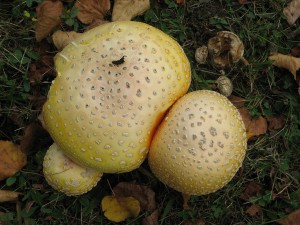Mushrooms Save the World

As were ambled along we came across a beautiful growth of Amanita Muscaria var Formosa mushrooms sprouting in the grass.
The largest cap was enormous, nearly 9 inches across, and a there were numerous smaller mushrooms spread about just hatching up through the ground. I took this picture…you can see on the left side of the big cap a bite mark where an animal took a little nibble.
Amanita Muscaria are the quintessential toadstool, with their vivid red caps dotted with white flecks. Very pretty and eye catching. The species that I found at Beechwood, Formosa, is not as vividly colored. The young caps are usually a deep copper color, and they fade to pale yellow as they mature.
They are reputed to be poisonous, and do contain mildly hallucinogenic properties, but some cultures use them as food.
This crop of Amanitas was so spectacular I went back a week later to photograph them again, as all the small mushrooms should have matured by then.
Sadly, someone else had found them before I got back…someone who obviously did not find them as lovely as I had. They had kicked and stomped every single mushroom into the ground. It was a completely pointless act of vandalism and destruction. Sigh.
However, the mushroom you see above the ground is merely the fruit, or flower if you will, of the actual mushroom mycelium that lives underground.
What the mushroom vandals did merely smashed up the fruit and did not harm the actual mushroom body itself. If you’ve crumbled rotten logs or dug up rich soil and found white threads spread throughout you have found the real body of a mushroom.
These mycelium bodies live underground and can spread over vast swathes of land. The largest single organism on the planet right now is a mushroom in Eastern Oregon. This organism is the spreading mycelium of a variety of Honey Mushroom. It covers nearly 10 square kilometers of area!
One of the most knowledgeable and visionary fungus scientists in the world today is Paul Stamets, a mycologist whose research center is in the Pacific Northwest.
Stamets has made many astonishing discoveries regarding the function of fungus on our planet.
He believes that mushrooms may hold the key to saving our world.
Mankind and mushrooms have a long history together. Mushrooms with psychoactive properties have been used in sacred practices since the dawn of history. Mushrooms and funguses have healed mankind for just as long.
Penicillin, of course, is made from a fungus, but mushrooms provide a vast array of many kinds of medicinal compounds.
The Lion’s Mane mushroom, for instance, has nerve-regenerative properties. In ancient Japan it was so revered that only the rulers were permitted to consume this mushroom.
Lion’s Mane aids in neurological function. Patients with mild cognitive impairment improved significantly while they ate the mushroom on a regular basis. Researchers are studying its compounds as they search for ways to help people with Alzheimer’s and dementia.
Lion’s Mane is a gourmet treat as well. It contains roughly 20 percent protein and can taste like lobster of shrimp.
The common oyster mushroom has been used to clean up oil spills with astounding results. Piles of dirt that are saturated with diesel fuel have been inoculated with oyster mushroom spores. Within a very short period of time, these lifeless piles if toxic dirt are covered with huge oyster mushrooms. The mushrooms consume the oil and as other plant seeds drift onto the piles of formerly poisonous soil, stuff begins to grow again!
Oyster mushrooms show great promise for decontaminating oil spills on water as well.
Since the Deepwater Horizon spill in April 2010, Stamets has been testing his oyster mushrooms for tolerance to salt water and sun So far, he’s managed to isolate a strain that can tolerate the salinity of Puget Sound, which is only slightly less than that of the Gulf. And he’s found ways to float the mushrooms cheaply on hemp “mycobooms” filled with straw and mycelia from which the mushrooms can metabolize oil on the surface of the sea
.
A world weaned off oil would be wonderful, but in the meantime discovering a non-toxic way to clean up oil pollution is a far better way to help heal the planet and its people.
Stephanie Kelley
